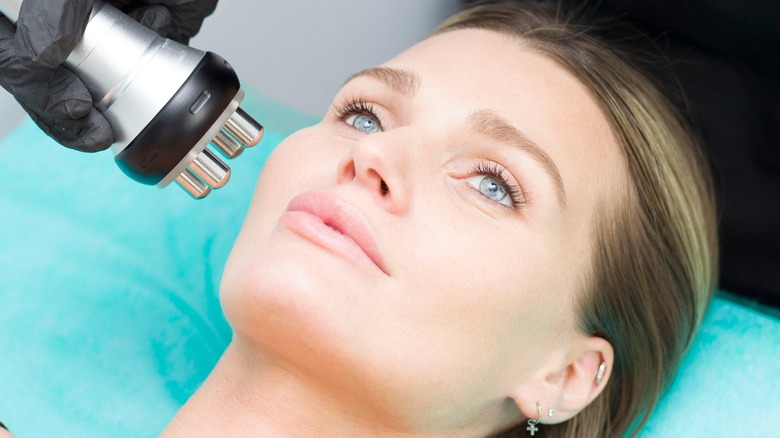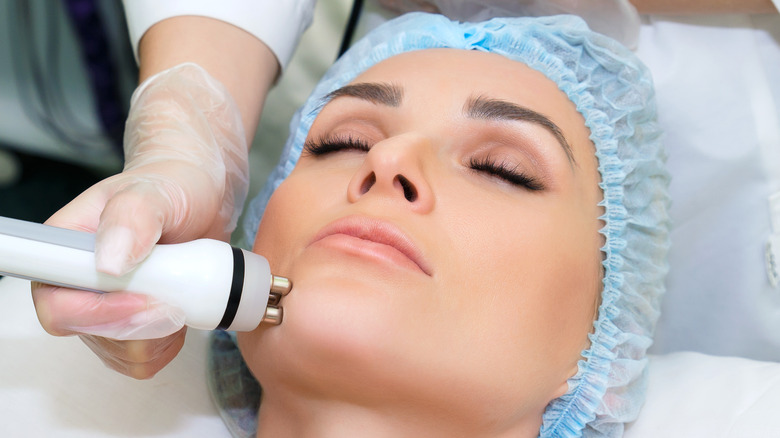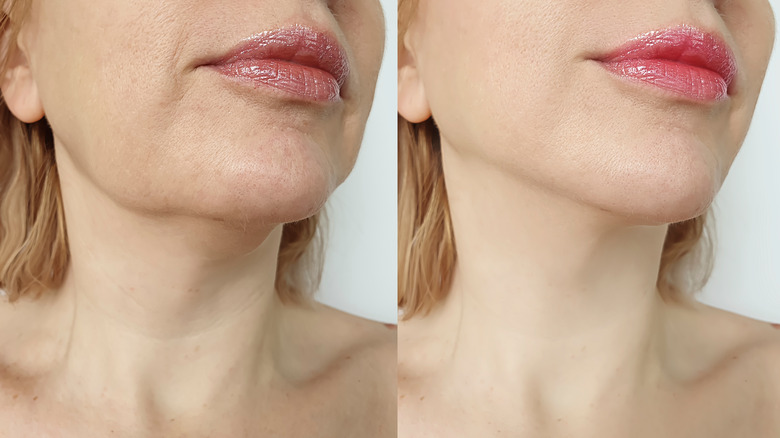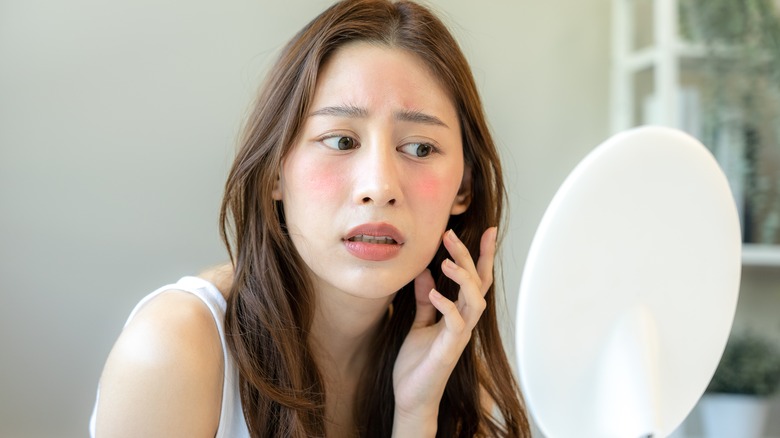Everything You Wanted To Know About Radiofrequency Skin Tightening
We may receive a commission on purchases made from links.
First, it's essential to understand what causes our skin to sag. When it comes to aging, we automatically think of fine lines and wrinkles, but there is more to it than that. As we get older, our body makes less collagen and elastin, and exposure to UV rays and free radicals depletes their production. Less collagen and elastin lead to loss of volume, which contributes to saggy skin (via American Self). Then, many want a solution to stop or repair this sagging.
While expensive creams and serums with peptides promise firmer skin with less sagging, the American Academy of Dermatology Association (AAD) says that pricey ointments can't give you the results you expect from a facelift. The most expensive creams will give you minimal effects compared to the most minor procedures, though the market is flooded with options, and we continue to buy them, hoping for change.
And that's the truth. When you want noticeable skin firmness, one of the best options is radiofrequency skin tightening, a non-invasive and non-surgical treatment to help saggy skin, skin laxity, and fine lines (via WebMD). The results may impress you more than the most expensive creams for sagging, and we're here to tell you everything you need to know about it.
What is radiofrequency skin tightening?
Radiofrequency skin tightening results won't be like you just got a facelift, but it will be pretty impressive. Regarding how it works, New York-licensed physician's assistant Gabrielle Garritano tells Byrdie, "This procedure uses energy waves to heat the deep layers of your skin (dermis), thus stimulating the production of fibroblasts, which play a critical role in the production of collagen and wound healing." Garritano adds that the energy waves make your skin contract, and voila: your skin feels firmer and tighter and you see results instantly.
What's more, board-certified dermatologist Corey L. Hartman tells Allure that radiofrequency skin tightening could help you in your 20s with acne scars and skin texture, while people in their 30s often use it to tighten the skin around their face, jawline, and neck. The older population turns to this procedure to make the effects of their facelifts last longer.
New York City-based dermatologist Dendy Engelman told the outlet, "[RF] raises [the treatment's] temperature, and then within four minutes, the heat causes apoptosis, which means the targeted fat cells are permanently damaged and naturally filtered out by the body." And the results are lifted and contoured appearance.
For fine lines and beginners, they use bipolar or multipolar RF (Venus Freeze, Endymed Tighten, and NuEra Tight), which is best for people in their 30s and 40s (via Get the Gloss). If you have deeper wrinkles and your skin has advanced sagging, they generally use monopolar or unipolar RF (Thermage, Pellevé, and Exilis Elite).
How to get the best results from radiofrequency skin tightening
Choosing a reputable and certified physician is one of the most important things before going for radiofrequency (RF) skin tightening. Ask questions before your appointment and be honest about your medical history to get the best results.
A study published in the Journal of Clinical and Aesthetic Dermatology notes that when RF maintains a temperature of over 115 degrees Fahrenheit for more than three minutes, it causes your body to release heat shock proteins that tell your body to make more collagen. Therefore, extra attention must be paid to the temperature and time used for a chiseled look. What's more, Gabrielle Garritano said you'll notice impressive results almost immediately after getting the treatment, per Byrdie. She adds, "Results last two-to-three weeks after the first treatment and longer after subsequent treatments," recommending that you get six sessions for longer-lasting benefits. After that, you'll only require one or two treatments for upkeep.
If you're just going for RF, you should be good to go with minimal recovery time, but your skin could be vulnerable to external stressors. Board-certified dermatologist Ava Shamban, M.D., tells Allure, "Generally, look for soothing, healing, and calming ingredients like hyaluronic acid, niacinamide, antioxidants, peptides, aloe, calendula, and petroleum- or glycerin-based [formulas]." This way, your skin can heal adequately. She recommends not using physical and chemical exfoliants, vitamin A derivates, or makeup and avoiding sweaty activities for up to 72 hours after the treatment.
Who can and can't do radiofrequency skin tightening
If you're looking for a little refresh without going under the knife, radiofrequency (RF) skin tightening is for you. In fact, facial plastic surgeon Dr. Maryam Zamani tells Get the Gloss, "Radiofrequency treatments can tighten the tissues just underneath the skin surface and contour the face, creating firm, toned, youthful-looking skin."
You can use this skin tightening procedure on various parts of your body with loose skin. It generally takes 30 to 90 minutes to complete depending on the area, though the face and the neck are the most common spots, per WebMD. It's enough for most people to have one treatment for results, which can last up to six months. The tightening effect will last longer if your skin is protected from the sun and skin care products are used. It's even been Food and Drug Administration (FDA) approved since 2002.
According to the IDS Clinic Singapore, specific populations should refrain from getting RF skin tightening. These include those who are pregnant or nursing, those who have rosacea or are sensitive to heat, and anyone with a metal implant like pacemakers. Furthermore, RF works for all skin types. However, Gabrielle Garritano doesn't recommend this procedure if you've had any recent microneedling, chemical peels, or dermal fillers, suggesting that you wait a month as it might cause adverse reactions (via Byrdie).
Side effects of radiofrequency skin tightening
Radiofrequency skin tightening is non-invasive, but it's not painless. RF heat goes deep into the skin, so numbing gel is typically applied to alleviate the pain. Like any procedure, it's essential to be mindful of the potential risks and side effects. Beverly Hills-based and board-certified plastic surgeon Ben Talei tells Allure, "RF can cause breakouts in certain patients for a few weeks." In fact, using occlusive skincare products could worsen it.
One of the reasons it's so important to go to a certified medical professional is that if used incorrectly, Dr. Talei adds, it could lead to unintended fat loss, dermal shrinkage, and face deflation. Despite being non-surgical, there is always a possibility of infection, too. On this, New York City-based dermatologic and surgeon Howard Sobel tells Byrdie, "There is a slight risk of infection at the insertion site, though this is extremely rare," and you could experience some redness, itching, and inflammation. While RF is a great choice to tighten skin, the long-term effects of using the procedure aren't entirely known. However, according to the American Cancer Society, there is no evidence that its harmful to people.
The cost of radiofrequency skin tightening
The price of a firmer, younger-looking face doesn't come cheap. According to CostHelper, the average cost of radiofrequency skin tightening ranges between $1,000 and $4,000 depending on the type of RF treatment you receive, the part of your body where you get it, the location of your practitioner, and the provider. Plus, you'll need one to five treatments. For example, for a treatment like Thermage that can only need one session, Lakeview Dermatology in Chicago, Illinois, charges $1,300 for the eyes and $2,000 for the face, and ReFirme, which requires three to five sessions, costs between $1,800 and $3,000. Moreover, it's vital to remember that most medical insurances won't cover RF because it's an elective procedure.
If you're not ready to spend the big bucks yet, you can try at-home radiofrequency devices. On this, Dr. Sophie Shotter tells Get The Gloss, "Radiofrequency is a safe and clinically effective technology to use at home. There are a few devices that have harnessed the power of RF in an FDA (an American standard ensuring the safety and efficacy of medical devices) cleared home-use device." We love the NuFace Trinity Facial Toning Device because using it for only five minutes a day can help lift and sculpt your face, which can reduce the appearance of fine lines and wrinkles. It's pricey but has great reviews and is much cheaper than in-office treatments.





